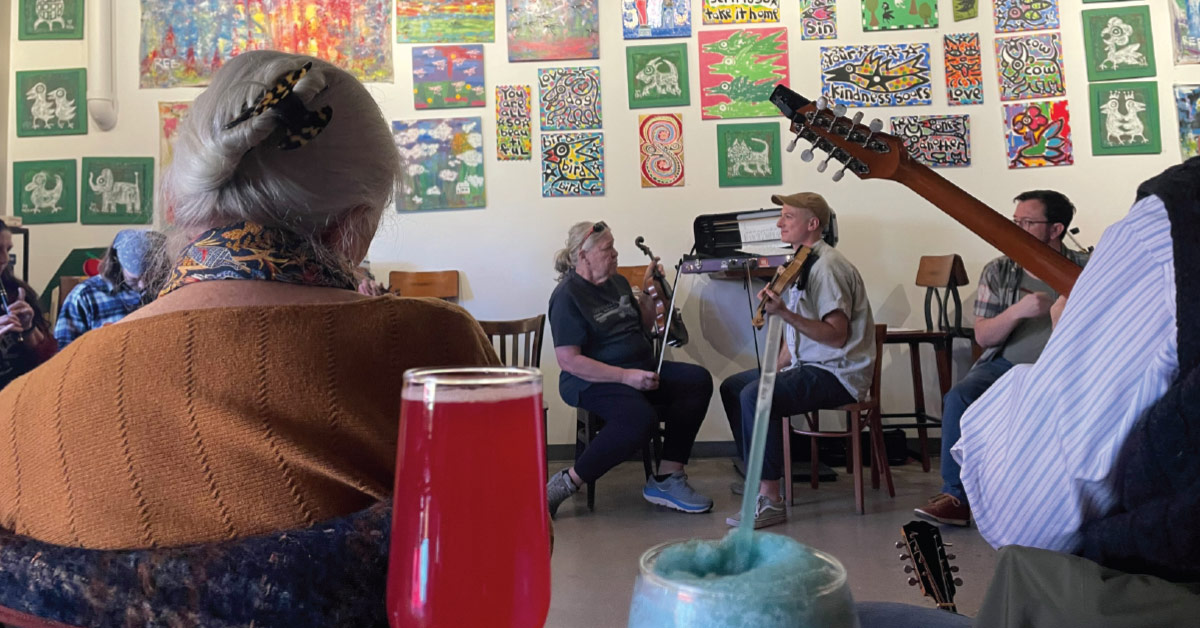Looking to mix live music with refreshing handcrafted beverages, but not interested in the usual bar open-mic scene? How about looking for an excuse to dust off your old fiddle or flute from high school?
In that case, Pux Cider off Fuller and Michigan has just the solution: Drop-In Traditional Irish Music Sessions.
What is traditional Irish music, and what does it sound like? Longtime Grand Rapids Irish Traditional Session group member, Dave Dimuzio, explains that this history of musical tunes (”tunes,” not “songs”) is first and foremost a melody-based tradition, one often meant to be played with a band of accompanying dancers. Unlike variations of “old-time” music, which traditional Irish music is regularly mistaken for, there are no breaks in the melody to feature particular instruments, and certainly no solos of any kind. Instead, the instrumentalists play in-one, altogether on the same line. However, there are always chances for deviation.
“There is some room for improvisation in these traditional tunes, to the extent that you’re adding ornamentation and staying within the structure of the melody,” said Zach Zeneberg, another session member. “There is a lot of variation there in how individual tunes are played.”
Zeneberg had been the one to connect Dimuzio and the rest of the Grand Rapids group, which have been making the trek out to Conklin Pub already for some decades, with Chris Schaefer and the rest of the Pux Cider team. He had been looking for a local sessions group much like the one he once played for in Ann Arbor, at a well-known sessions spot called Conor O’Neill’s Irish Pub. First hearing Irish music at a young age and continuing now into his 30’s, Zeneberg is glad to have developed what was once only his hobby into a new lifelong practice.
“The whistle and the flute, in Irish traditional music in particular, are the one thing I feel I’ve come to a place where I can make good music with it,” Zeneberg said.
Dimuzio, who plays the fiddle, began playing Irish music more seriously, much like Zeneberg, somewhere around his mid-twenties. Now, having traveled to Ireland and back, and with more than a few decades of experience under his belt, Dimuzio has spearheaded a dedicated group of 15 to 30 musicians who meet several times a month to share space with each other and play tunes that are hundreds of years old.
“What we do is ask people, going around the circle, what they’d like to play,” Dimuzio said. “We could change, go back the other way and have leadership who picks the tunes, but I would find that a little less inclusive.”
That traditional style is pervasive throughout most of the Irish music sessions you might come across, which vary widely by geography and expectation of skill. For Dimuzio and Zeneberg’s group, they prefer a more comfortable approach, where volunteers may bring an instrument and play along to the tunes they do know. Or, folks can sight-read along to something they may not.
“Someone who is starting should not be worried about memorizing a tune,” Dimuzio said. “Bring your sheet music, bring a tablet.”
Interested in seeing how much of a “drop-in” atmosphere these Irish music sessions might actually be, I decided to visit the group one Sunday afternoon, dusting off my passed-down violin.
On the day, I arrived early along with the rest of my fellow musicians. The group skews older, but not by much. The younger players, including myself, occupied each corner of the naturally-lit room, offering sounds from completely different musical families.
By my count, while taking a break with a “Noble Pursuit” spiked slushie in hand, there were three Irish whistles, three fiddles, two guitars, one bass, four bodhráns, three different mandolins, one bouzouki, and probably a dozen other instruments either set aside on stands or tucked away in nearby travel cases, ready to be played at a moment’s notice. Jason, a young man who sat beside me and another fiddler, Kathy, informed me he’d normally bring in his Appalachian banjo, but instead, today, brought his 10-string mandolin.
On particularly fast songs, he’d confidently set the mandolin down and pick up his bodhrán, a one-skinned drum that sits on your knee and is hit with the palm of your hand. Kathy, who very generously lent me her tablet to read sheet music off from, was sure to encourage me on the more difficult tunes, even at one point dramatically shrugging to me at the bar to show she’s not always clear on what’s meant to be played either. After all that practice, she’d been stumped, too.
At the start of the session and, frankly, my conversation with Dimuzio and Zeneberg, that was still my big unanswered question: How can it all possibly work? When twenty or so near-strangers gather in one spot and play together, impromptu tune after impromptu tune and oftentimes completely by memory, how could they possibly sound...together? I asked this question to the group, some time after we had begun and I’d requested the one tune I practiced: “Midnight On The Water.”
“This is folk music, it doesn’t have to be exactly the same,” Kathy said. “As long as it doesn’t clash.”
It may have been only my first time joining them, and especially after some five odd years since playing my instrument seriously, but I don’t think I saw many ways a person might clash there. With friendly faces, good drinks, and pleasant sounding music, the GR Irish Sessions group fosters a community space for everyone—yourself included. Just bring along your fiddle!
For more information, you can join the Grand Rapids Traditional Irish Session group on Facebook.





